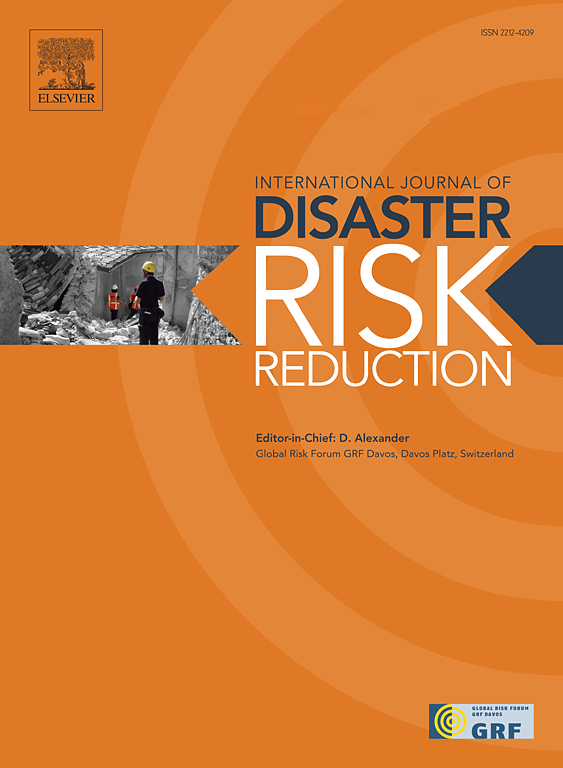描述印度特里普拉近实时(NRT)洪水淹没和损害评估的综合地理空间方法
IF 4.2
1区 地球科学
Q1 GEOSCIENCES, MULTIDISCIPLINARY
International journal of disaster risk reduction
Pub Date : 2025-05-02
DOI:10.1016/j.ijdrr.2025.105547
引用次数: 0
摘要
洪水是最具破坏性的水文气象灾害之一,对生命、财产、农业和基础设施造成了一系列破坏。在印度东北部的特里普拉邦(Tripura),由于丘陵地形和强降雨的影响,它具有弹性,但容易受到季风引发的洪水的冲击。本研究的任务是评估2024年8月严重季风洪水期间戈马提、西帕希贾拉、南特里普拉和西特里普拉四个地区的洪水淹没地图及其对农业和建成区的影响。利用Sentinel-1合成孔径雷达(SAR)和EOS 04 MSR SAR数据的力量,本研究揭示了对洪水范围和影响的近实时洞察。利用谷歌地球引擎(GEE)和SigmaSAR V3.1,可以在很短的时间内对卫星数据集进行处理和分析。将SAR图像与随机森林土地利用和土地覆盖(LULC)分类技术相结合,在绘制洪水淹没图和评估损害方面具有不可估量的价值。结果显示,在85021.46公顷的农业用地中,有10510.32公顷被淹没,其中戈马提和西特里普拉邦面临的挑战最大,占总农田的13%。在建成区方面,75180.26公顷的总面积中有928.72公顷受到影响,其中戈马提区遭受的洪水最严重,占建成区的1.5%。这些发现有力地推动了加强洪水管理战略,激发了改进早期预警系统和创新城市规划的必要性。本文章由计算机程序翻译,如有差异,请以英文原文为准。
Comprehensive geospatial approaches to delineate near real-time (NRT) flood inundation and damage assessment of Tripura, India
Floods are among the most devastating hydro-meteorological hazards, leaving behind a trail of destruction to life, property, agriculture, and infrastructure. In northeastern India, Tripura stands resilient yet vulnerable to the onslaught of monsoon-driven floods, shaped by its hilly terrain and heavy rainfall. This study embarks on a mission to assess flood inundation mapping and the impact on agricultural and built-up areas in four districts: Gomati, Sipahijala, South Tripura, and West Tripura, during the severe monsoon floods of August 2024. Harnessing the power of Sentinel-1 Synthetic Aperture Radar (SAR) and EOS 04 MSR SAR data, this study unveil near real-time insights into the flood's extent and effects. By utilizing Google Earth Engine (GEE) and SigmaSAR V3.1, satellite datasets have been processed and analyzed in a very short time. The integration of SAR imagery with Random Forest land use and land cover (LULC) classification techniques proves invaluable for mapping flood inundation and assessing damage. The results reveal that out of 85021.46 ha (ha) of agricultural land, 10,510.32 ha were inundated, with Gomati and West Tripura facing the greatest challenges, where 13 % of the total farmland was flooded. In the realm of built-up areas, 928.72 ha of the total 75180.26 ha were affected, with Gomati District experiencing the most significant inundation, marking 1.5 % of its built-up regions flooded. These findings serve as a strong impetus for enhanced flood management strategies, igniting the need for improved early warning systems and innovative urban planning.
求助全文
通过发布文献求助,成功后即可免费获取论文全文。
去求助
来源期刊

International journal of disaster risk reduction
GEOSCIENCES, MULTIDISCIPLINARYMETEOROLOGY-METEOROLOGY & ATMOSPHERIC SCIENCES
CiteScore
8.70
自引率
18.00%
发文量
688
审稿时长
79 days
期刊介绍:
The International Journal of Disaster Risk Reduction (IJDRR) is the journal for researchers, policymakers and practitioners across diverse disciplines: earth sciences and their implications; environmental sciences; engineering; urban studies; geography; and the social sciences. IJDRR publishes fundamental and applied research, critical reviews, policy papers and case studies with a particular focus on multi-disciplinary research that aims to reduce the impact of natural, technological, social and intentional disasters. IJDRR stimulates exchange of ideas and knowledge transfer on disaster research, mitigation, adaptation, prevention and risk reduction at all geographical scales: local, national and international.
Key topics:-
-multifaceted disaster and cascading disasters
-the development of disaster risk reduction strategies and techniques
-discussion and development of effective warning and educational systems for risk management at all levels
-disasters associated with climate change
-vulnerability analysis and vulnerability trends
-emerging risks
-resilience against disasters.
The journal particularly encourages papers that approach risk from a multi-disciplinary perspective.
 求助内容:
求助内容: 应助结果提醒方式:
应助结果提醒方式:


